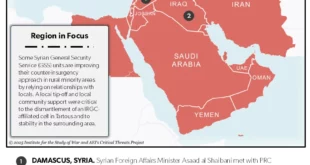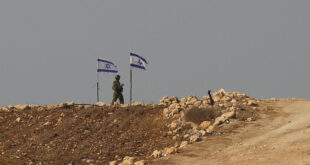It has been months since the Islamic State was expelled from its territorial control in Iraq and Syria, but the brutal terrorist outfit continues to wreak havoc in the lands it once deemed its “caliphate.”
Between May 5 and June 3, the U.S-led Combined Joint Taskforce’s Operation Inherent Resolve – the name given to the mission to defeat ISIS – conducted 11 strikes consisting of 34 engagements against ISIS targets in Iraq. More than 20 caves, two vehicles and a one-bedroom infrastructure were decimated. At least three ISIS terrorists were killed in tunnels 40 miles west of Ramadi, Iraqi defense officials reported.
And across the war-ravaged nation, the ISIS bloodletting goes on.
The Iraqi Civil Defense Directorate affirmed last week that more than 6,100 acres of agricultural crops were incinerated in less than two weeks in 136 separate incidents, with the at-risk area spanning almost 120,000 acres of Iraqi land. ISIS has claimed responsibility for numerous blazes in recent weeks, justifying their targeting of wheat crops as retaliation against those refusing to pay them taxes.
Iraq’s security forces last week also opened fire on two alleged ISIS suicide bombers that were preparing to detonate at security forces positioned in the Abar area near Fallujah. That same day, ISIS operatives executed a large-scale onslaught against the Shiite Population Mobilization Forces (PMF) between Baghdad and further south to Babylon province.
And the night before, ISIS snipers were reported to have killed at least three soldiers and wounded another 17 in Tarmiya city, just north of Baghdad.
That’s just a small snapshot over a small time window amid the ongoing effort to root out ISIS operatives from Iraq once and for all.
“Depriving ISIS of its territorial control in Iraq and Syria is a positive step, but ISIS as a terrorist organization and ideology is by no means defeated,” Bradley Bowman, Senior Director of the Center on Military and Political Power (CMPP) for the Foundation for Defense of Democracies, told Fox News. “The sustainable defeat of ISIS will require a comprehensive strategy—working with our allies—to kill irreconcilable terrorists, address the underlying ideology, and promote inclusive governments in Damascus and Baghdad.”
And while the whereabouts of the elusive ISIS leader Abu Bakr al-Baghdadi – the most wanted man in the world – remains unknown, Iraqi intelligence believes he continues to bark orders to the various cells disseminated across remote regions.
Over the border in Syria, ISIS too maintains a shadowy presence. Data from the Rojava Information Center recorded that, for the month of May alone, at least 78 deaths occurred as a result of 139 ISIS sleeper cell attacks across the Northeastern swath of the country.
“Attacks and deaths are increasing month-on-month, with deaths up 42 percent since April and attacks up 61 percent,” the report stated.
The report also underscored that there were 42 armed attacks or ambushes – a 62 percent jump on the previous month – there were 69 bombings, a 73 percent rise, 22 assassinations and 6 executions after capture, up 33 percent. Attacks in the previously secure Jazirah region also ascended some 163 percent to 21, as ISIS spawned from its epicenter of Deir ez-Zor, which experienced 87 attacks in May, a leap of 28 percent over the previous month.
The U.S.-supported Syrian Democratic Forces (SDF) were documented to have arrested more than 100 sleeper cell members in intense raids, focused mostly on the Deir ez-Zor area.
In Bowman’s view, premature withdrawal from Syria would almost guarantee that the U.S. will have to return later at a higher cost.
“It would also empower Russia, Iran, and Hezbollah while putting our ally Israel at greater risk,” he said. “As long as Assad remains in power, it will be difficult to address Sunni grievances that have created the fertile recruiting ground for ISIS.”
Globally, ISIS remains a potent force as well. Aside from the devastating Sri Lanka Easter attacks that killed hundreds – of which ISIS claimed responsibility – the group also cemented a new milestone on Thursday claiming an attack in Mozambique for the first time. In its subsequent statement, according to the Jihad and Terrorism Threat Monitor issued by the Middle East Media Research Institute (MEMRI), ISIS boasted that their “Caliphate soldiers” clashed with local Army forces, “using various weapons, killing and wounding several (after which) the mujahedeen seized weapons, ammunition, and rockets.”
In April, ISIS also aggrandized its first-ever assault in the Democratic Republic of Congo, which killed eight Congolese soldiers. The barbaric insurgency has also endeavored to expand its footprint of terror across other prominent parts of West Africa, Libya, Sinai, Yemen, Algeria, and Southeast Asia. Notably, it is believed to be doubling down in the lawless regions of Afghanistan, under its umbrella “Khorasan” affiliate.
Moreover, ISIS hasn’t slowed on its plethora of taunts and teases in the West, either. As just one example last week, the pro-ISIS Muntasir Media released a new poster featuring France’s famed Eiffel tower, a bloody knife and a French police insignia in cross-hairs and was shared on Telegram channels with the caption “Kill all National Police.”
In light of ISIS’s losses on the battlefields of Iraq and Syria and the fall of the so-called caliphate, ISIS regional affiliates around the world in places like North Africa, the Sahel, and the Philippines,” added Raphael Marcus, a visiting research fellow in the Department of War Studies, King’ College London. “It will likely attempt to carry out attacks in order to bolster ISIS’s global standing.”
 Eurasia Press & News
Eurasia Press & News


